Study on the Optical Properties of the Point-Focus Fresnel System
Abstract
:1. Introduction
2. Materials and Methods
2.1. The Point-Focus Fresnel System
2.2. Computational Methods
- (1)
- The receiver plane is discretized into a grid of equidistant nodes;
- (2)
- As shown in Figure 2, in order to calculate the flux density on the receiver plane, the grid nodes are projected onto the image plane in the direction to the center of the heliostat;
- (3)
- The flux density at projected point of the image plane is calculated by using the Gaussian flux density function which is shown in Table 2;
- (4)
- The flux density at a point of the receiver plane is proportional to that of its projected point of the image plane, although affected by the angel of incidence with the receiver plane, ω. The relationship between the flux density at a point of the receiver plane and the flux density at the projected point of the image plane satisfies:where Freceiver is the solar flux density on the receiver plane, dreceiver is the distance from the grid nodes on the receiver plane to the center of the heliostat; Fimage is the solar flux density on the image plane, dimage is the distance from the grid nodes on the image plane to the center of the heliostat.
2.3. SolTrace Code
2.4. The Calculation Method of Average Absolute Difference for Flux Contours
2.5. Intercept Factor Calculation
3. Results
3.1. Model Validation: Compared to SolTrace
3.2. The CPU Time of the SolTrace Code and Proposed Method
4. Discussion
- The contribution to the reflected rays from the optical error of the heliostat is different in different positions of the heliostat [13]. However, proposed method in this paper assume that it’s average, which would bring some errors;
- It will bring some error to simulate the image function of the heliostat by Gaussian distribution.
5. Conclusions
Author Contributions
Funding
Institutional Review Board Statement
Informed Consent Statement
Data Availability Statement
Acknowledgments
Conflicts of Interest
References
- Peng, H.; Weidong, H. Study on solar optics and industrialization of solar thermal power generation. China Sci. Technol. Achiev. 2020, 21, 4–5. [Google Scholar]
- Peng, H.; Weidong, H. Performance Analysis and Optimization of an Integrated Azimuth Tracking Solar Tower. Energy 2018, 157, 247–257. [Google Scholar]
- Collado, F.J. Quick evaluation of the annual heliostat field efficiency. Sol. Energy 2008, 4, 379–384. [Google Scholar] [CrossRef]
- Kistler, B.L. A User’s Manual for DELSOL3: A Computer Code for Calculating the Optical Performance and Optimal System Design for Solar Thermal Central Receiver Plants; Technical Report; SAND86-8018; Sandia National Lab: Albuquerque, NM, USA, 1986. [Google Scholar]
- Vant-Hull, L. The role of “Allowable Flux Density” in the design and operation of molten-salt solar central receivers. Sol. Energy 2002, 2, 165–169. [Google Scholar] [CrossRef]
- Weidong, H.; Liang, Y. Development of a new flux density function for a focusing heliostat. Energy 2018, 151, 358–375. [Google Scholar]
- Wendelin, T. SolTrace: A Ray-Tracing Code for Complex Solar Optical Systems; Technical Report; National Renewable Energy Lab (NREL): Golden, CO, USA, 2013. [Google Scholar]
- Collado, F.J. One-point fitting of the flux density produced by a heliostat. Sol. Energy 2010, 4, 673–684. [Google Scholar] [CrossRef]
- Alberto, S.G.; Domingo, S. Solar flux distribution on central receivers: A projection method from analytic function. Renew. Energ. 2015, 74, 576–587. [Google Scholar]
- Biggs, F.; Vittitoe, C.N. Helios Model for the Optical Behavior of Reflecting Solar Concentrators; Technical Report; Sandia National Lab: Albuquerque, NM, USA, 1979. [Google Scholar]
- Rabl, A. Active Solar Collectors and Their Applications; Oxford University Press: New York, NY, USA, 1985; p. 181. [Google Scholar]
- Xiao, Z. Engineering Optical Design; Publishing House of Electronics Industry: Beijing, China, 2003. [Google Scholar]
- Weidong, H.; Yongping, L.; Zhengfu, H. Theoretical analysis of error transfer from surface slope to refractive ray and their application to the solar concentrated collector. Renew. Energ. 2013, 74, 562–569. [Google Scholar]
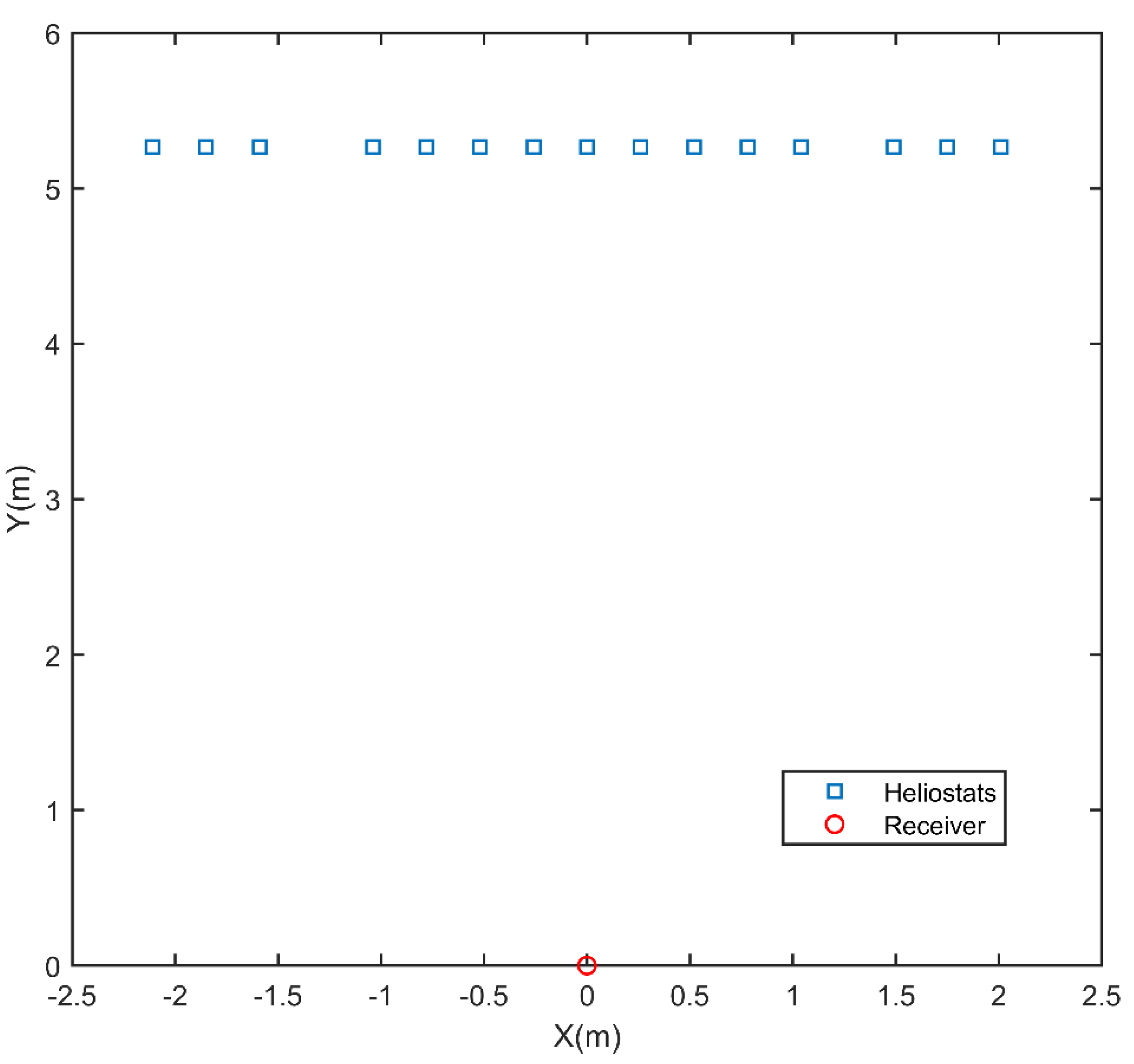
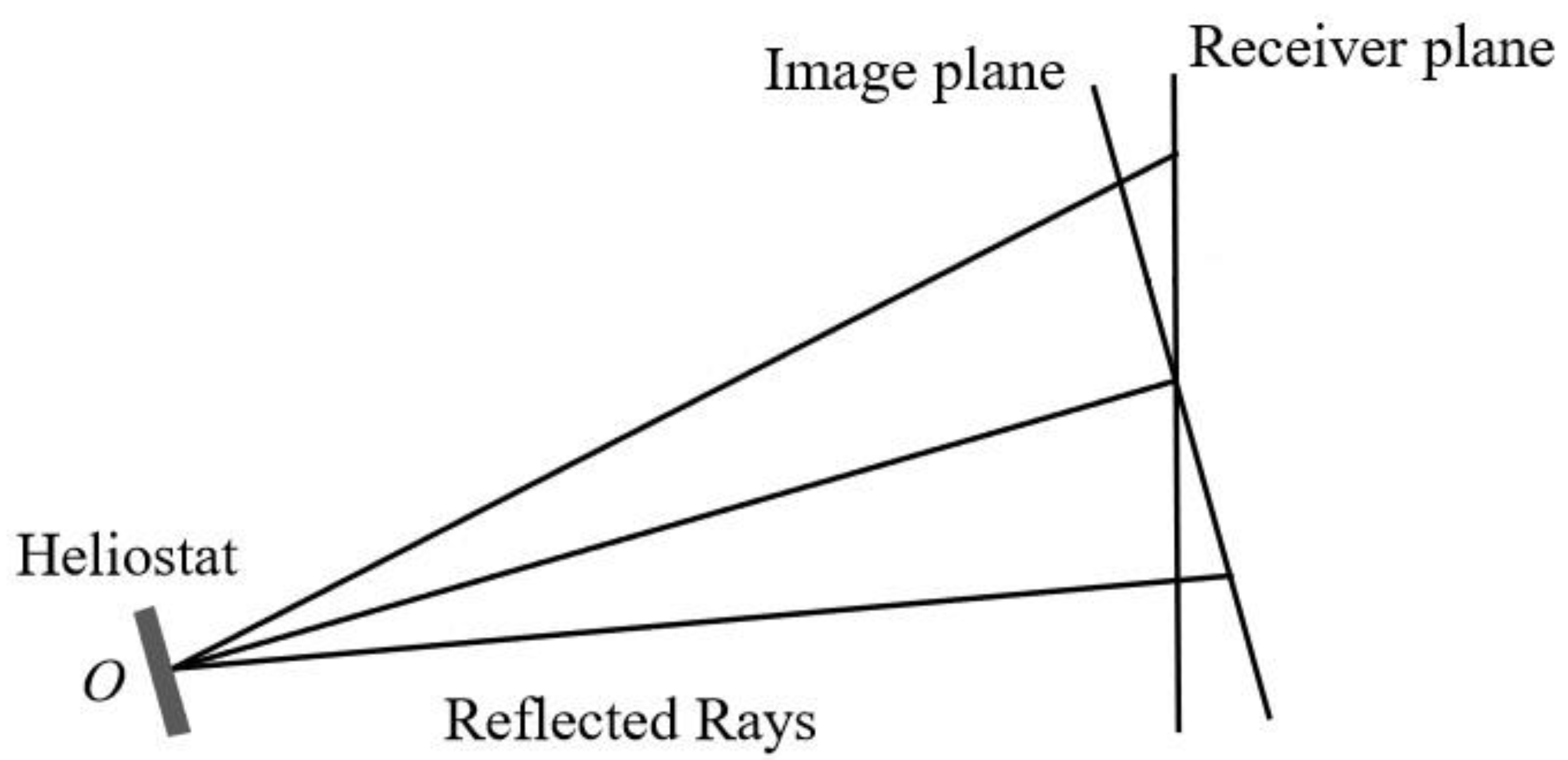
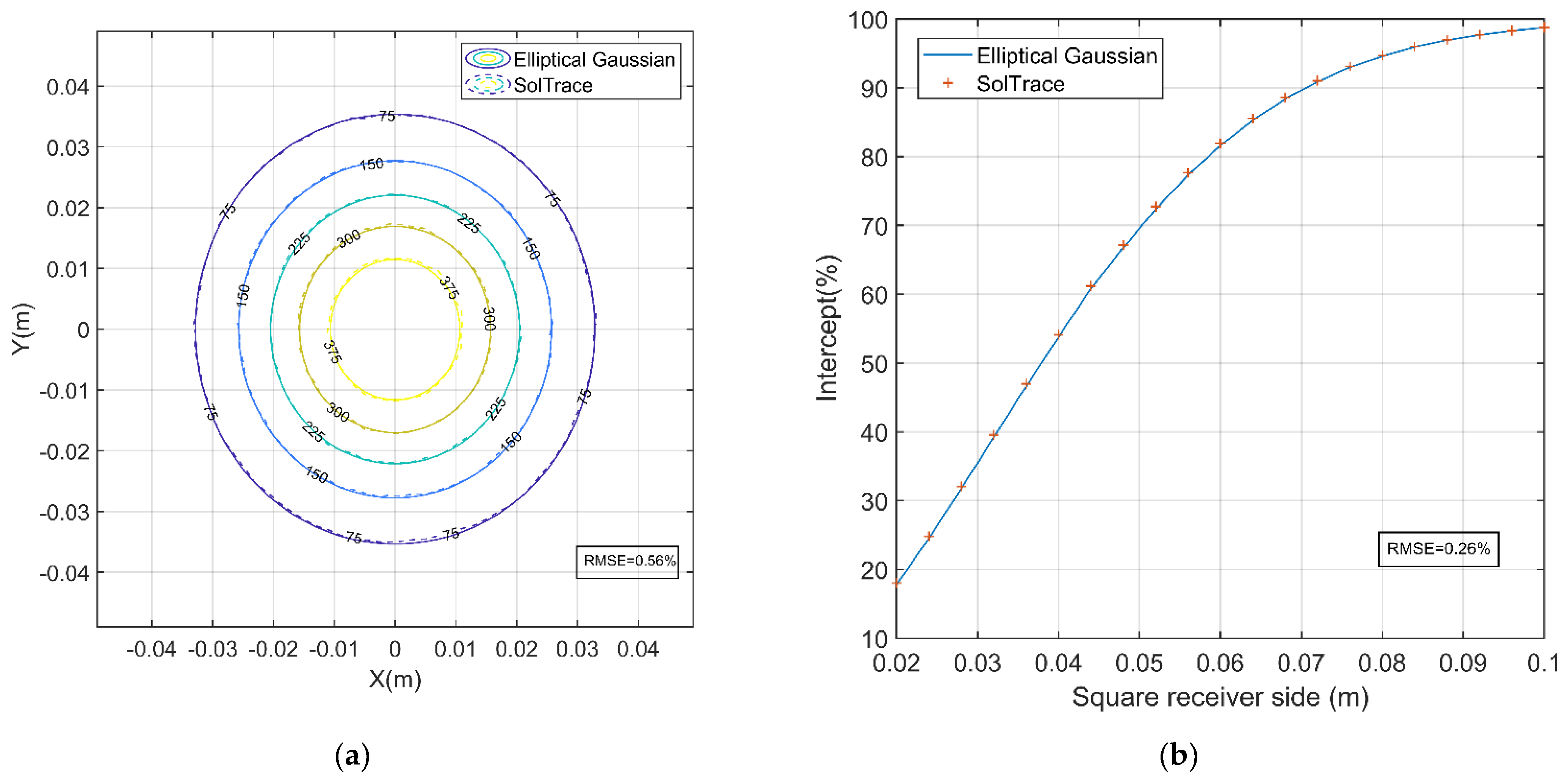
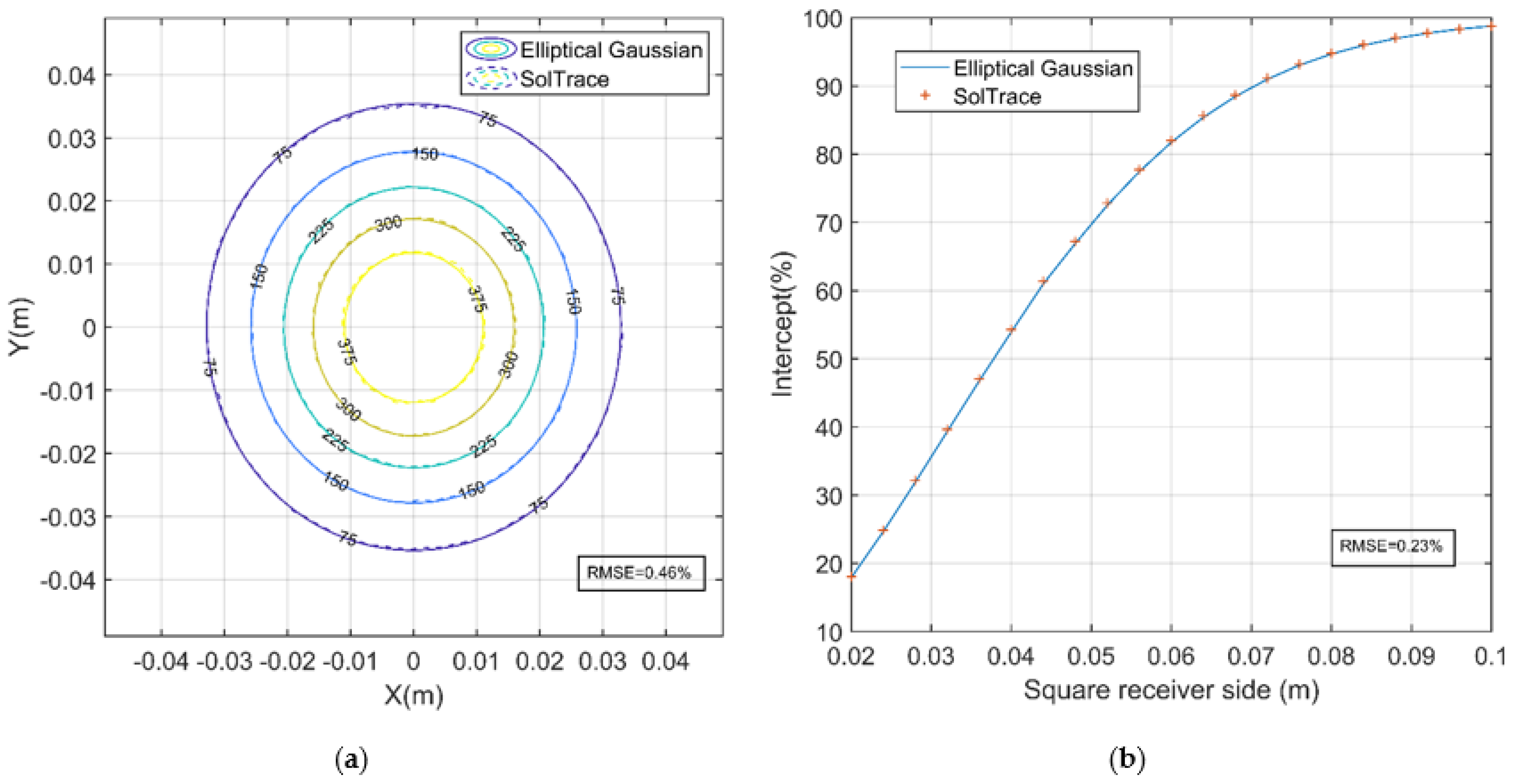
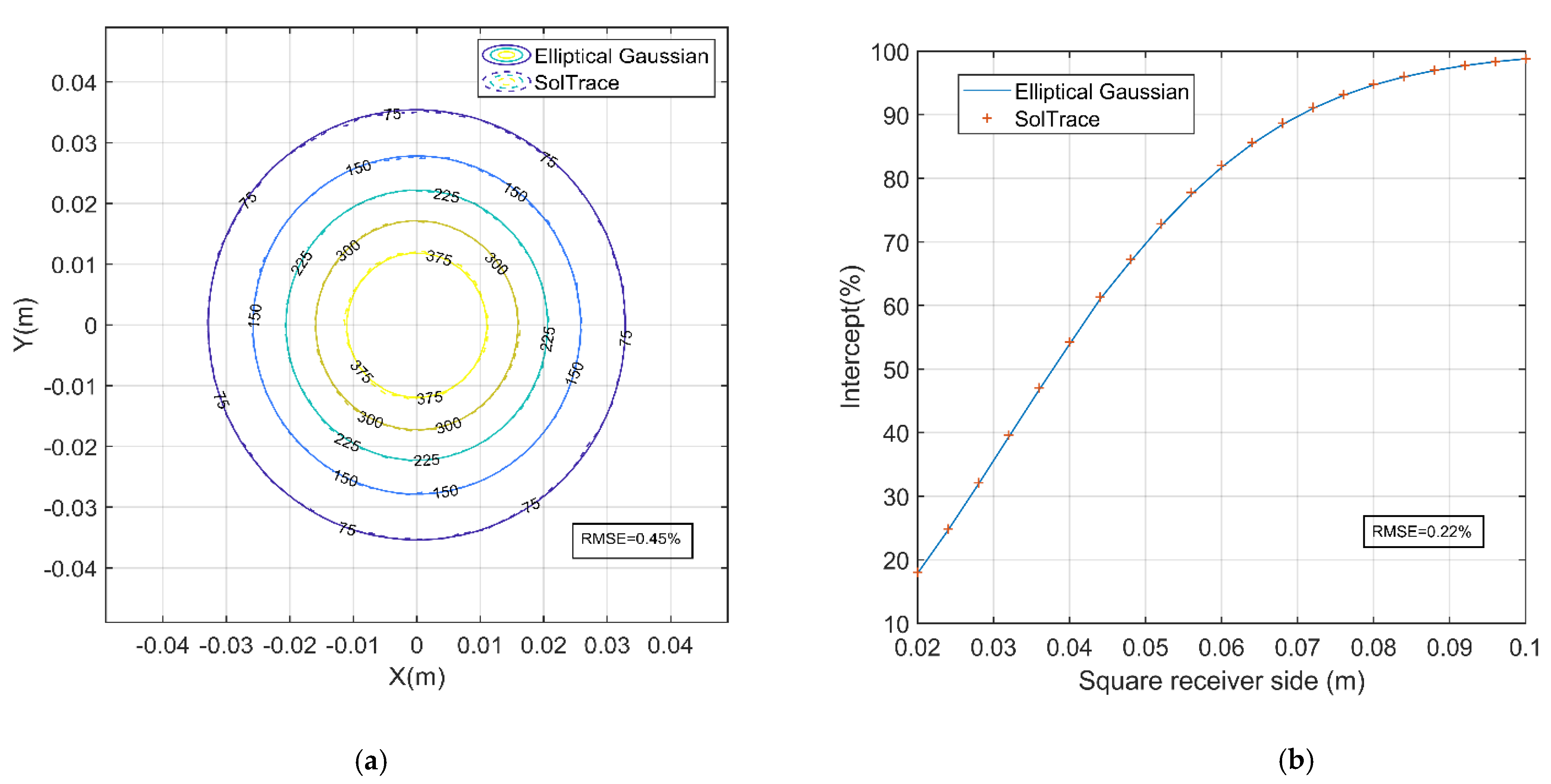
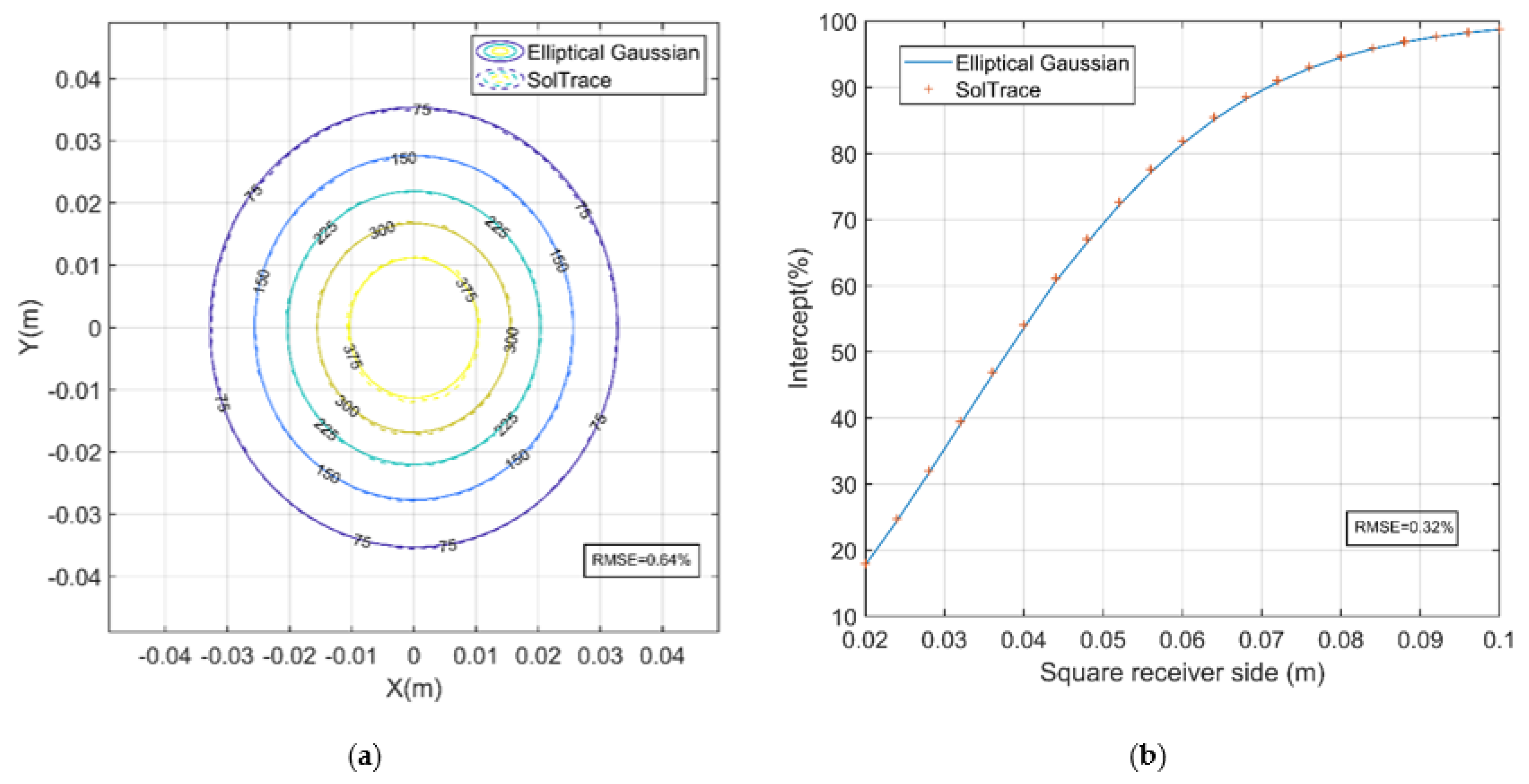

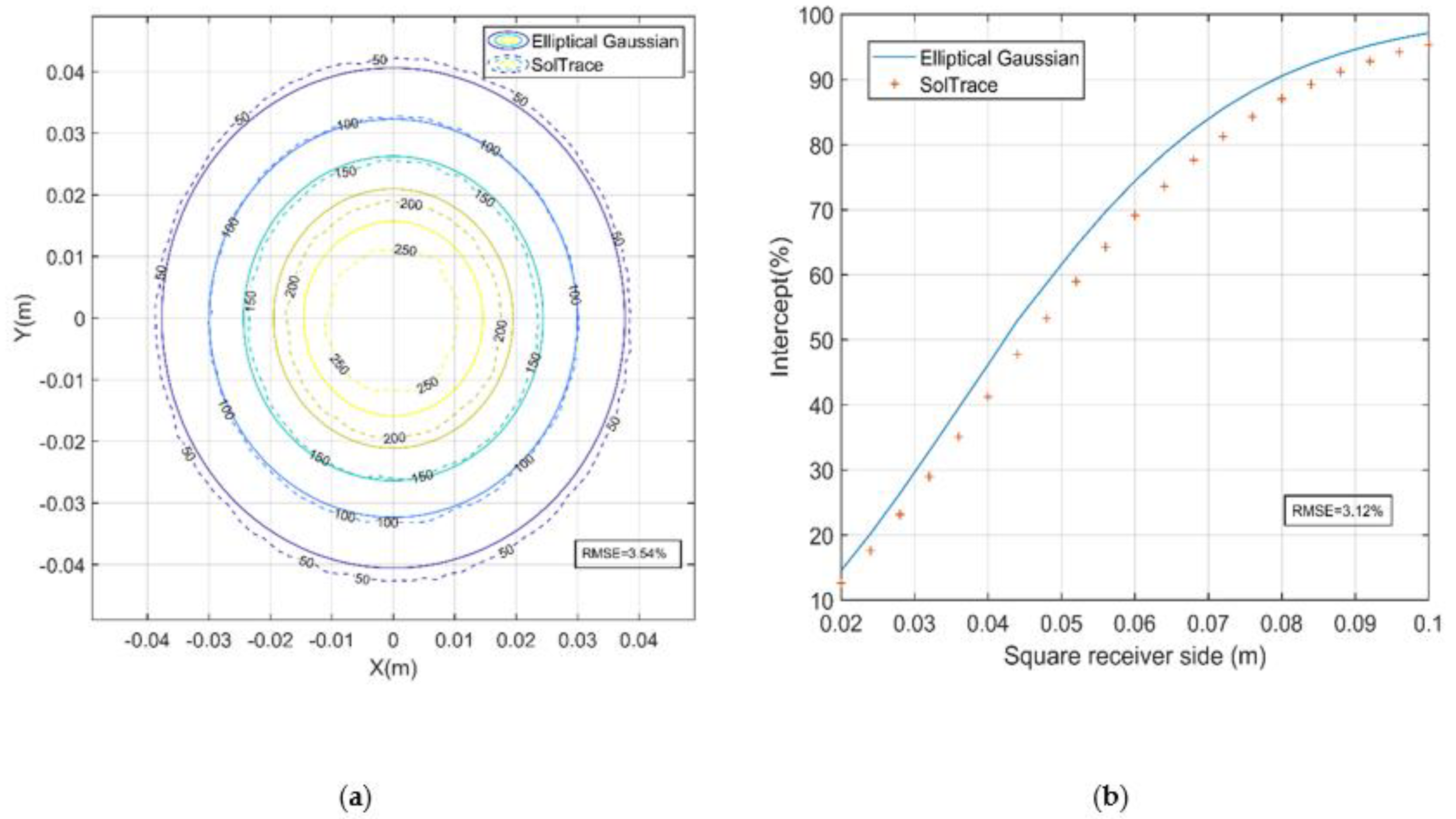

| # | X(m) | Y(m) | Z(m) | Focal Length (m) | Length and Width (m) |
|---|---|---|---|---|---|
| 1 | 2.01 | 5.2659 | 0 | 5.9 | 0.25 × 0.25 |
| 2 | 1.75 | 5.2659 | 0 | 5.9 | 0.25 × 0.25 |
| 3 | 1.49 | 5.2659 | 0 | 5.9 | 0.25 × 0.25 |
| 4 | 1.04 | 5.2659 | 0 | 5.9 | 0.25 × 0.25 |
| 5 | 0.78 | 5.2659 | 0 | 5.9 | 0.25 × 0.25 |
| 6 | 0.52 | 5.2659 | 0 | 5.9 | 0.25 × 0.25 |
| 7 | 0.26 | 5.2659 | 0 | 5.9 | 0.25 × 0.25 |
| 8 | 0 | 5.2659 | 0 | 5.9 | 0.25 × 0.25 |
| 9 | −0.26 | 5.2659 | 0 | 5.9 | 0.25 × 0.25 |
| 10 | −0.52 | 5.2659 | 0 | 5.9 | 0.25 × 0.25 |
| 11 | −0.78 | 5.2659 | 0 | 5.9 | 0.25 × 0.25 |
| 12 | −1.04 | 5.2659 | 0 | 5.9 | 0.25 × 0.25 |
| 13 | −1.59 | 5.2659 | 0 | 5.9 | 0.25 × 0.25 |
| 14 | −1.85 | 5.2659 | 0 | 5.9 | 0.25 × 0.25 |
| 15 | −2.11 | 5.2659 | 0 | 5.9 | 0.25 × 0.25 |
| Gaussian Model | Flux Density Function | The Calculation Equations of Main Parameters |
|---|---|---|
| Elliptical (for rectangular heliostats) |
| Incident Light Intensity | Reflectivity | σsun | σslopex,y | σtrk |
|---|---|---|---|---|
| 1 kW/m2 | 1 | 2 mrad | 1 mard | 0 |
| Altitude Angle of the Sun | 10° | 20° | 30° | 45° | 60° | 75° |
|---|---|---|---|---|---|---|
| Flux density | 0.56% | 0.46% | 0.45% | 0.64% | 0.80% | 3.54% |
| Intercept | 0.26% | 0.23% | 0.22% | 0.32% | 0.70% | 3.12% |
Publisher’s Note: MDPI stays neutral with regard to jurisdictional claims in published maps and institutional affiliations. |
© 2021 by the authors. Licensee MDPI, Basel, Switzerland. This article is an open access article distributed under the terms and conditions of the Creative Commons Attribution (CC BY) license (https://creativecommons.org/licenses/by/4.0/).
Share and Cite
Shen, F.; Huang, W. Study on the Optical Properties of the Point-Focus Fresnel System. Sustainability 2021, 13, 10367. https://doi.org/10.3390/su131810367
Shen F, Huang W. Study on the Optical Properties of the Point-Focus Fresnel System. Sustainability. 2021; 13(18):10367. https://doi.org/10.3390/su131810367
Chicago/Turabian StyleShen, Fei, and Weidong Huang. 2021. "Study on the Optical Properties of the Point-Focus Fresnel System" Sustainability 13, no. 18: 10367. https://doi.org/10.3390/su131810367
APA StyleShen, F., & Huang, W. (2021). Study on the Optical Properties of the Point-Focus Fresnel System. Sustainability, 13(18), 10367. https://doi.org/10.3390/su131810367





